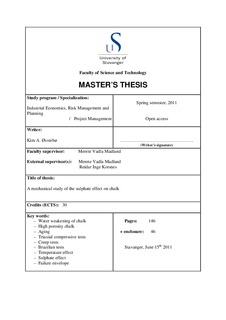| dc.description.abstract | The main objective of this thesis was to investigate any possible effects of sulphate on the
mechanical strength of chalk. Related to this, the following sub-objectives can be listed:
Investigating temperature effect on chalk’s mechanical strength, obtaining estimates of
chalk’s failure envelope (in a q-p’ plot) at different testing conditions and with different
brines, and estimate the cohesion (S0) and friction angle (φ) of the chalk.
High porosity outcrop chalk from Liège was tested experimentally in two different cell types,
and by performing four different types of tests at two different temperature conditions.
Hydrostatic, deviatoric and creep tests were carried out in triaxial test cells, while Brazilian
tests were performed in a Brazilian test cell. By the use of a heating jacket mounted onto the
triaxial cells, and a heating element connected to the front cover of the Brazilian cell, it was
possible to perform high temperature tests at 130 °C. About half of the tests were carried out
at ambient temperature, so that also the temperature effect could be studied. The testing brine
used in the work with this thesis was mainly synthetic seawater without sulphate (SSW–
(SO4
2–)). Due to close co-operation with a student working on a corresponding, parallel
master thesis, results from identical tests carried out by the use of synthetic seawater (SSW)
as testing brine were also provided. This gave the opportunity to study any possible sulphate
effects on the mechanical strength of chalk.
A total of 57 chalk cores, with an average porosity of 39.57%, were saturated with testing
brine before testing. All cores tested at high temperature were also aged in an aging cell at
130 °C for three weeks prior to testing. Results from Brazilian, deviatoric (with varying
degree of radial support) and hydrostatic tests at different testing conditions could be
presented in Mohr diagrams where mechanical parameters could be determined, and also in qp’
plots where estimated failure envelopes (consisting of shear failure line and end cap line, at
which shear failure and pore collapse is the dominating failure mechanisms, respectively)
could be compared. Estimated mechanical parameters were also determined from the shear
failure line in the q-p’ diagram, and showed a good match with the values obtained from the
Mohr circle plots.
Experimental results showed that chalk tested at 130 °C was weaker when sulphate was
present in the pore fluid, both when regarding shear failure and pore collapse. On average, at
high temperature testing yield points and Young’s moduli values were a factor approx. 1.3
higher for tests where sulphate was not present. At ambient temperature, no clear sulphate
effect was observed. In fact, if any trend could be noticed at all, it would be that chalk
experienced a higher resistance against shear failure when sulphate was present in the fluid.
When comparing temperature conditions for all tests run with the use of SSW as testing brine,
it was found that yield points and elasticity moduli values for ambient temperature tests were
on average a factor 1.5 higher than for high temperature tests. Thus, sulphate seems to have a
weakening effect on chalk at high temperature, while no clear trend is seen at ambient
temperature. In the absence of sulphate, there did not seem to be any clear temperature effect.
V
High temperature (130 °C) creep test results showed that deformation was to a large extent
dependant on the presence of sulphate in the continuously flooded fluid. Measured in terms of
axial strain, the deformation obtained from flooding synthetic seawater (SSW) was at a
certain creep time (≈ 32,000 minutes) a factor 1.62 higher than what was observed when
SSW–(SO4
2–) was flooded. In addition, it was observed that when sulphate was introduced to
the pore fluid during creep, this generated a significantly increasing deformation. The
opposite was observed when sulphate was removed, typically indicated by the creep straincreep
time curve flattening out. The “introduction” and “removing” of sulphate was simply
obtained by changing flooding brine between SSW and SSW–(SO4
2–).
Chemical analyses of water samples of the effluent water during creep showed large
additional production of calcium (from the chalk) and extensive losses of magnesium from the
aqueous solution. The latter observation is most likely a result of precipitation of magnesium
bearing minerals. Indications of sulphate precipitation as anhydrite (CaSO4), probably, were
also seen, as well as it seemed that the immediate reaction of introduced sulphate ions was
dependent on the previous flooding fluid(s) and possible actions they would cause inside the
chalk. | en_US |
